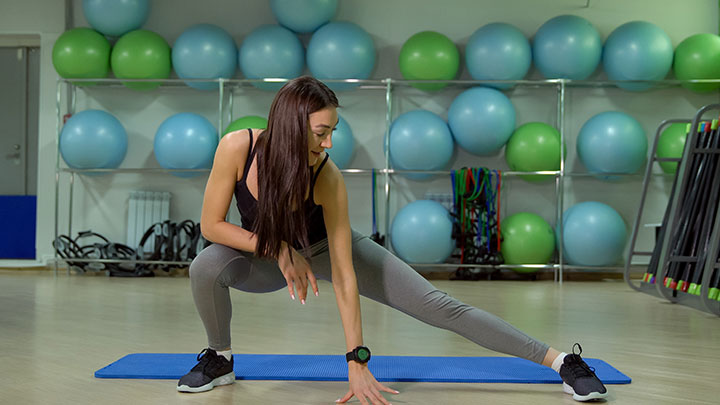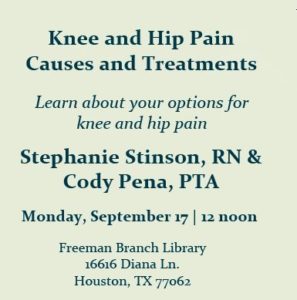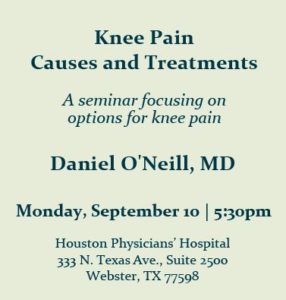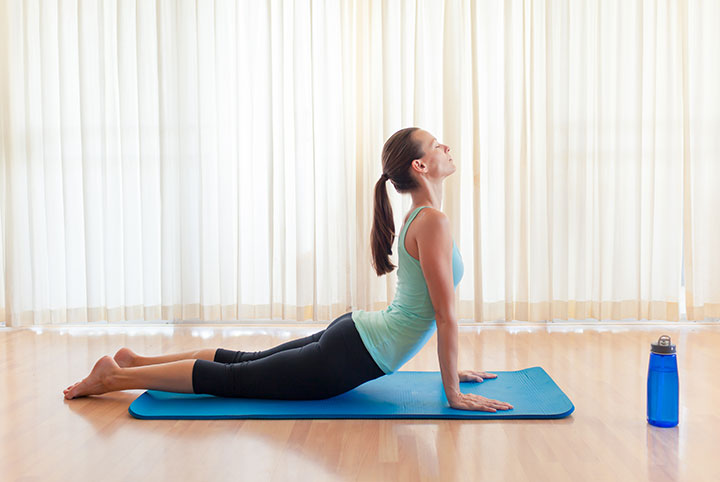The summer months often consists of getting outdoors and getting active. Whether it’s walking along the beach or going out for a morning bike ride, the summer months are perfect for being active. However, those affected by hip pain may feel unable to perform their favorite seasonal activity. At Houston Physicians’ Hospital, we understand it can be difficult when hip pain holds you back, so we’ve laid out some helpful information on what may be causing your pain and when it’s time to seek orthopedic treatment:
- Osteoarthritis
According to The New England Journal of Medicine, osteoarthritis is the most common disorder of the joints in the United States (1). A variety of factors can cause this condition in the hips, including age and trauma. Osteoarthritis occurs when the cushioning cartilage in the hip joints begin to break down and cause the bones to rub against each other as you move.
- Stress Fractures
The American Academy of Physical Medicine and Rehabilitation cites repetitive movements that place excessive stress on the bone as the most common cause of stress fractures in the hip (2). Typically, stress fractures occur in those involved in high-impact sports, or sports that place a lot of stress on the hip joints, like running.
- Snapping Hip Syndrome
According to The American Journal of Sports Medicine, snapping hips syndrome is characterized by hip pain, along with a “snapping” sound coming from the hip joints during movement, and is most common among young adults (3). Typically, three causes lead to this syndrome: the IT band snapping over the outside of the thigh, the deep hip flexor snapping over the front of the hip joint, and tears of the cartilage that surrounds the hip socket.
- Hip Labral Tear
An article published in Current Reviews in Musculoskeletal Medicine describes the symptoms associated with a hip labral tear as groin pain, pain in the buttocks, and mechanical symptoms such as clicking or locking in the hip joint (4). This condition can be caused by a variety of factors, including heredity conditions, trauma, and repetitive motions. A tear in the hip labrum can cause a large amount of pain, as it causes a disruption in the cartilage’s normal function of holding the ball of the thigh bone securely in the hip socket.
When Should I Seek Treatment for My Hip Pain?
Many of these conditions require the help from physicians at Houston Physicians’ Hospital in the Clear Lake area to help manage symptoms and receive the proper form of treatment. However, it can be difficult to determine when it’s time to seek a professional for your hip pain. Typically, the most common sign that you need to seek treatment is an inability to perform daily activities due to your hip pain. However, there are some other common symptoms that indicate it’s time for expert treatment:
- Hip pain when at rest
- Swelling, redness, or a warm sensation around the hip joint
- Hip pain following an injury or fall
- Sudden onset of hip pain
For those affected by hip pain in the Clear Lake area, give Houston Physicians’ Hospital a call at (281) 557-5620. We’re a leading name in orthopedic pain management and treatment.
- https://www.nejm.org/doi/full/10.1056/nejmcp071112
- https://now.aapmr.org/stress-fracture-of-the-hip/
- http://journals.sagepub.com/doi/abs/10.1177/036354658401200504
- https://link.springer.com/article/10.1007/s12178-009-9052-9


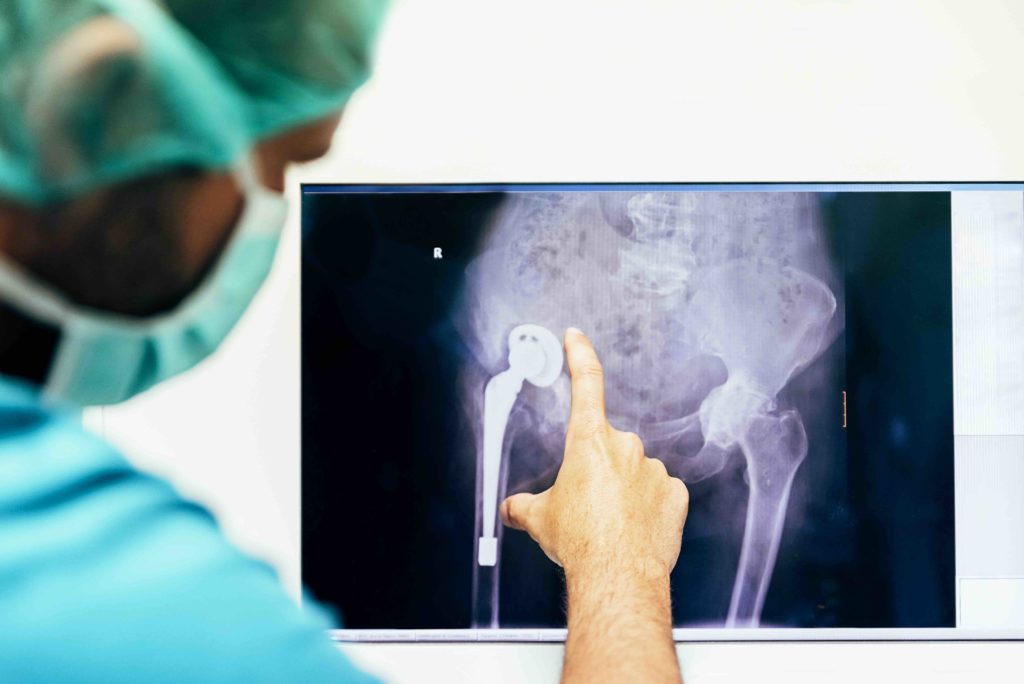



 [/vc_column_text][/vc_column][vc_column width=”1/4″][vc_row_inner css=”.vc_custom_1523302075660{background-color: #003a59 !important;}”][vc_column_inner][vc_custom_heading text=”EVENT INFORMATION” font_container=”tag:h4|text_align:left|color:%23ffffff” use_theme_fonts=”yes”][vc_separator color=”white” border_width=”2″][/vc_column_inner][/vc_row_inner][vc_row_inner css=”.vc_custom_1523302436586{background-color: #003a59 !important;}”][vc_column_inner][vc_custom_heading text=”Event Date : October 1, 2018″ font_container=”tag:h4|text_align:left|color:%23ffffff” use_theme_fonts=”yes”][vc_separator color=”custom” accent_color=”#33617a”][vc_custom_heading text=”Event Time : 5:30 – 7:00 P.M.” font_container=”tag:h4|text_align:left|color:%23ffffff” use_theme_fonts=”yes”][vc_separator color=”custom” accent_color=”#33617a”][vc_custom_heading text=”Department : Orthopedics” font_container=”tag:h4|text_align:left|color:%23ffffff” use_theme_fonts=”yes”][vc_separator color=”custom” accent_color=”#33617a”][vc_custom_heading text=”Doctor : Eduardo A. Garcia, M.D.” font_container=”tag:h4|text_align:left|color:%23ffffff” use_theme_fonts=”yes”][vc_separator color=”custom” accent_color=”#33617a”][vc_custom_heading text=”Location : 333 North Texas Avenue, Suite 2500 Webster, Texas” font_container=”tag:h4|text_align:left|color:%23ffffff” use_theme_fonts=”yes”][vc_separator color=”custom” accent_color=”#33617a”][/vc_column_inner][/vc_row_inner][vc_empty_space][vc_single_image image=”4527″ img_size=”full” alignment=”center”][/vc_column][/vc_row]
[/vc_column_text][/vc_column][vc_column width=”1/4″][vc_row_inner css=”.vc_custom_1523302075660{background-color: #003a59 !important;}”][vc_column_inner][vc_custom_heading text=”EVENT INFORMATION” font_container=”tag:h4|text_align:left|color:%23ffffff” use_theme_fonts=”yes”][vc_separator color=”white” border_width=”2″][/vc_column_inner][/vc_row_inner][vc_row_inner css=”.vc_custom_1523302436586{background-color: #003a59 !important;}”][vc_column_inner][vc_custom_heading text=”Event Date : October 1, 2018″ font_container=”tag:h4|text_align:left|color:%23ffffff” use_theme_fonts=”yes”][vc_separator color=”custom” accent_color=”#33617a”][vc_custom_heading text=”Event Time : 5:30 – 7:00 P.M.” font_container=”tag:h4|text_align:left|color:%23ffffff” use_theme_fonts=”yes”][vc_separator color=”custom” accent_color=”#33617a”][vc_custom_heading text=”Department : Orthopedics” font_container=”tag:h4|text_align:left|color:%23ffffff” use_theme_fonts=”yes”][vc_separator color=”custom” accent_color=”#33617a”][vc_custom_heading text=”Doctor : Eduardo A. Garcia, M.D.” font_container=”tag:h4|text_align:left|color:%23ffffff” use_theme_fonts=”yes”][vc_separator color=”custom” accent_color=”#33617a”][vc_custom_heading text=”Location : 333 North Texas Avenue, Suite 2500 Webster, Texas” font_container=”tag:h4|text_align:left|color:%23ffffff” use_theme_fonts=”yes”][vc_separator color=”custom” accent_color=”#33617a”][/vc_column_inner][/vc_row_inner][vc_empty_space][vc_single_image image=”4527″ img_size=”full” alignment=”center”][/vc_column][/vc_row]